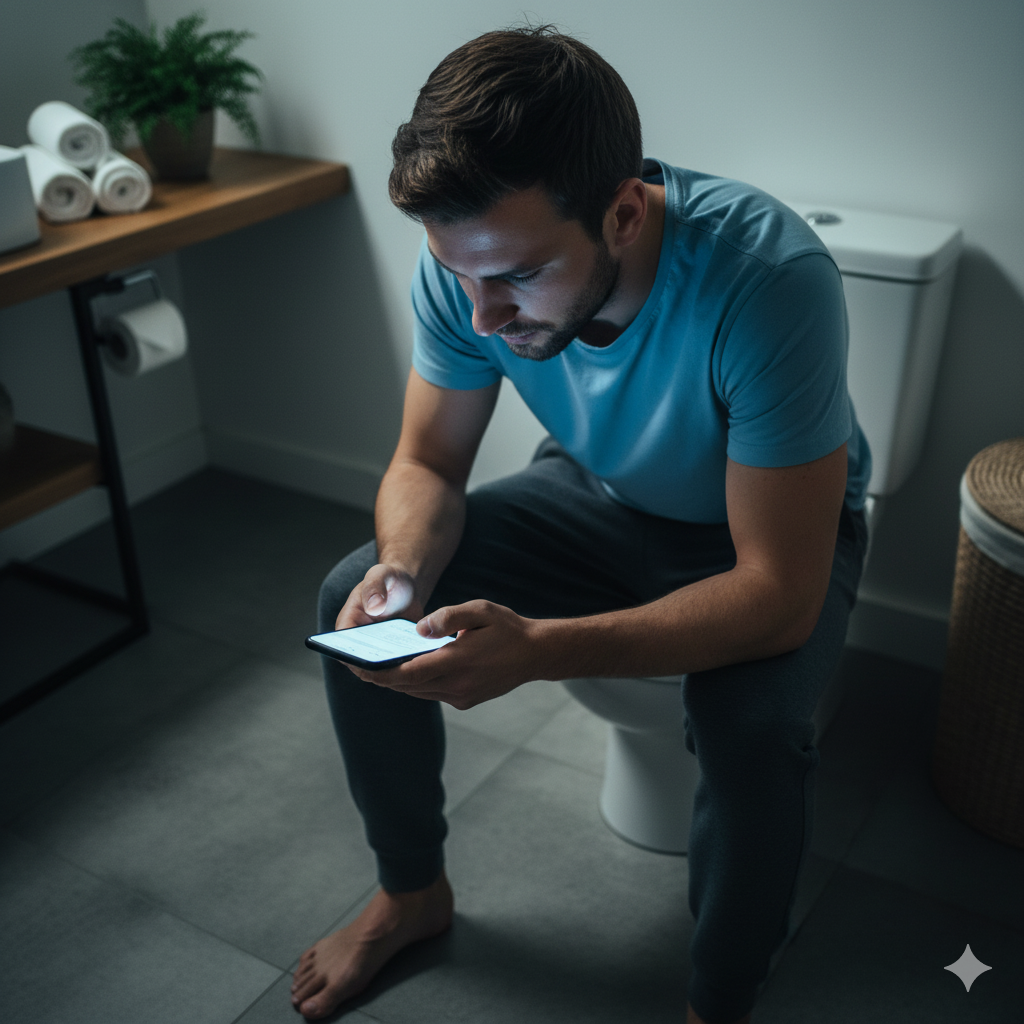The smartphone has become the ubiquitous companion for modern life, a portal to news, social media, and endless distraction—even in the most private of spaces.1 But this innocent habit of “toilet scrolling” has come with a surprising, and often painful, medical warning: an increased risk of hemorrhoids.2
Recent research is transforming what was once anecdotal advice into a scientifically-backed health concern, suggesting that your time spent glued to the screen on the commode is directly contributing to this common ailment.3

🚨 The 46% Higher Risk
A study published in PLOS One investigated the link between smartphone use on the toilet and the presence of hemorrhoids, confirming a significant association.4 Researchers found that adults who use their smartphones while sitting on the toilet were 46% more likely to have hemorrhoids compared to non-users, even after adjusting for traditional risk factors like age, sex, BMI, exercise, and fiber intake.5
The key driver behind this alarming statistic is simple: Time.
| Habit | % Spending > 5 Minutes on the Toilet | Outcome |
| Smartphone Users | 37.3% | 46% increased risk of Hemorrhoids |
| Non-Users | 7.1% | Baseline risk |
Smartphone users were found to linger on the toilet significantly longer, with a large percentage spending over five minutes per visit—a duration almost five times greater than non-users.6 This prolonged sitting is the critical, modern-day trigger.7
🩸 The Physiological Price of Distraction
Why does prolonged sitting on the toilet lead to hemorrhoids? It comes down to basic anatomy and gravity.8
Hemorrhoids are essentially swollen and inflamed veins, or vascular cushions, in the lower rectum and anus.9 They are a normal part of the body, helping with bowel control.10 However, when excessive pressure is applied, these cushions can become engorged and displaced, leading to symptoms like itching, pain, and bleeding.11
Getty Images
- Gravity and Pressure: Unlike a regular chair that supports the pelvic floor, a standard toilet seat leaves the anal area and lower rectum unsupported and slightly lower than the rest of the body.12 When you sit for an extended time (like 5+ minutes), gravity causes blood to pool in the rectal veins.13
- Venous Congestion: This pooling and subsequent compression from the toilet rim put continuous, disproportionate pressure on the delicate veins.14 The longer you sit, the more backpressure builds, causing the vascular cushions to swell, stretch, and eventually become symptomatic hemorrhoids.
- The Time Trap: Smartphones, by their nature, are attention traps, making you lose track of time while scrolling through social media or reading news.15 This passive engagement ensures you remain in the high-pressure, hemorrhoid-inducing position far longer than necessary.16
💡 The Solution: A Five-Minute Rule
Medical professionals have long advised against spending too much time on the toilet, with some suggesting a maximum limit of about five minutes.17 The research confirms that the problem is less about straining (the classic culprit) and more about the duration of sitting facilitated by our digital devices.18
Actionable Advice to Save Your Rear End:
- Implement a ‘No-Phone Zone’: The most effective way to limit your time is to simply leave your smartphone outside the bathroom.19 Going number two should be your number one priority.
- The ‘Two-Minute Drill’: If you must take your phone, set a timer for a maximum of two to five minutes. Once the time is up, get off the toilet, even if you feel you haven’t finished.20 You can always try again later.
- Manage Constipation: While prolonged sitting is a direct risk, constipation and straining remain primary causes. Increase your intake of fiber (fruits, vegetables, whole grains) and fluids to ensure soft, easy-to-pass stools.21
- Don’t Postpone: Respond to the urge to go immediately. Waiting allows stool to harden, increasing the likelihood of straining.
The convenience of digital distraction comes with a hidden cost. By treating the toilet as a momentary necessity, rather than a digital reading lounge, you can significantly reduce the risk of a painful, yet often preventable, health condition.
Leave a Reply